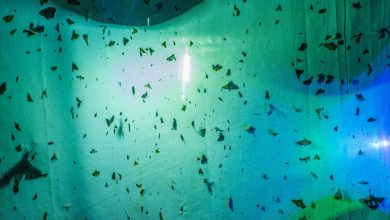Why Salmon and Rice Go So Well Together

It has been years since my mother roasted a salmon head. But I can still hear that tick-tocking toaster oven, a sign of the dish’s imminent arrival at our dinner table. The “head” part of it all was scary to me as a child, but as an adult, I find myself craving the fishy butteriness of the cheek meat, what I call the bone marrow of the sea. Stirred through a bowl of freshly steamed Calrose rice (maybe with a dab of doenjang, that salty dream of a soybean paste), roasted salmon head is easily in my Top 10 favorite things to eat. But without the rice? Not so much.
Maybe it’s because salmon and rice belong together like cereal and milk. The rich, fatty salmon is tempered by the comfortingly bland white rice, the latter absorbing what the former renders in excess. The twin-flame combo may be one of nature’s purest forms of culinary symbiosis.
The rice farmer John Brennan has a saying: If you’re in the rice industry, you’re in the water industry, and if you’re in the water industry, you’re in the fish industry. When Brennan, an owner of Robbins Rice Company, described to me the life cycle of his rice, it sounded like a prose poem. As he recited the steps, I fell into a reverie: The whole drama takes about 150 days — May to October usually. The water is turned on for some 120 of those days, then turned off so the field can drain. Thirty days later, you harvest the rice. Then, you’re left with a field of dried rice stubble. Until 30 years ago, rice farmers could go skiing in the off-season, he said. But today, farmers are feeling pressure to do more with that spare time. For Brennan, the question is no longer just: How much rice did you produce? It’s also: How are you giving back to the land, and what are you doing with it in the months when you’re not growing rice?
Here’s what Brennan is doing: collaborating with the scientist Jacob Katz to turn a piece of the Sacramento Valley, specifically in the Yolo Bypass, into a floodplain that can be home to baby Chinook salmon during the winter months, as they make their way down the river system to the Pacific. Their experiment, aptly named the Nigiri Project (in reference to the beds of seasoned sushi rice draped in little blankets of raw fish), involves flooding Brennan’s rice fields once the grain has been harvested so that the depleted stalks can decompose in the water, thereby making those nutrients available to bugs and plankton, which then serve as food for schools of growing salmon. Puddles of muddy water, it turns out, are excellent “batteries” for the life cycles of salmon and rice. In his experiments, Katz found that not only did the fish he added to these puddles survive — they thrived, doubling their weight from week to week. “This is what a Sacramento salmon actually looks like, when you re-expose it to the conditions it was adapted to,” Katz says. “A real river system is the interaction between the water and the landscape through which it flows, and when you mimic those interactions, that’s when you ignite the explosion of natural productivity that allows for environmental abundance.”
Every sentence that comes out of Katz’s mouth is convincing, full of charisma and urgency. “I do my best to simplify the science and make it approachable,” he says. And for Katz, who loves to cook, food is one of the best ways to meet consumers where they are. Whenever he cuts into a big, beautiful California Chinook, for instance, he can’t resist taking a bite out of the belly. It’s his favorite part. He also does what I do to good wild salmon: He cuts the larger fillet into smaller medallions, which means there’s more surface area for the fat to render quickly in a hot oven without the flesh drying out. When you roast smaller chunks of salmon like this, just until they’re still pink and supple in the middle, they melt in your mouth. “Few things are better than a wedge of fish protein on a bed of rice,” he told me. With those tender nuggets, Katz enjoys a bowl of Brennan’s semi-brown rice, which is nuttier than white and full of flavor. “When you bring the rice up into equal footing with the fish: That’s badass.”
They say what grows together goes together — and across cultures, cuisines and households, salmon goes with rice. A simple salmon teriyaki comes to mind, a saucy and welcome accompaniment to steamed rice, as do various iterations of sake don, the raw salmon and rice bowl that is often bejeweled with the fish’s own roe, those gleaming orange pearls. Platters of salmon nigiri flooded my childhood birthday dinners, and on weeknights when it was just Mom and I, the occasional salmon head made an appearance.
In my kitchen now, I like to marinate cubes of boneless salmon fillets in a mixture of mirin and doenjang, whose fermented soybean flavor anchors the sauce with funk and umami, then roast them hot and fast. The rice in this case is not optional; it soaks up the salty-sweet glaze, which itself is streaked through with glorious salmon fat. And with leftovers, in the style of the TikTok star Emily Mariko, I sometimes stir through a spoonful of sriracha or chile-garlic sauce, plus a little mayonnaise, and enjoy that tangle of salmon and rice with kimchi, gim and sliced avocado.
You could also skip all of that. But here’s the thing: You can’t skip the rice. Without it, something would be missing.
Recipe: Doenjang Salmon Rice Bowl



